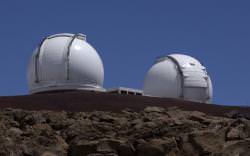Astronomers used to think that brief stellar eruptions called novae generated massive amounts of dust. But new observations of a well known nova system called RS Ophiuchus shows that isn’t the case. The dust was there already, and a nova blast just clears it all away.
The discovery was made using the massive Keck Interferometer, where the two 10-metre (33 feet) Keck telescopes on Hawaii’s Mauna Kea are merged together into a single super-telescope. It’s not like some kind of Japanese anime robot linking together; the telescopes just sit there. All the merging is done behind the scenes, through optics, electronics, and computers.
The Keck Interferometer can null the light coming from a star, revealing its surroundings. This allows the combined instrument to see objects with 10 times more resolving power than a single telescope working alone.
This “nulling mode” is largely used to reveal planet-forming disks of gas and dust surrounding distant stars. With the nuller blocking the starlight, the dimmer disk can be revealed.
In this recent observation, the Keck Interferometer observed a nova in a star surrounded by a dusty disk. The system contains a white dwarf and a red giant. The red giant is shedding its outside layers, while the white dwarf is gobbling it up.
Once a certain amount of matter piles up on the surface of the white dwarf, it explodes in a bright nova. This star has had 5 outburst over the last 100 years, so astronomers knew it would be flaring up again shortly.
The astronomers didn’t see any dust in the inner regions near the star – it was probably vaporized in the explosion. But around 20 times the Earth-sun distance, the researchers did see the dust again.
This flies in the face of what we expected. Astronomers had previously thought that nova explosions actually create dust,” said Richard Barry of Goddard, lead author of the paper on the observations that will appear in the Astrophysical Journal. They were expecting the nova to generate the dust. But instead, the dust was already there, and the nova just illuminated it.
The researchers now think that the dust is created as the star passes through the red giant’s wind, creating a pinwheel pattern around it. The denser regions in this pinwheel are cool enough to stick together to form dust particles. The blast wave from the nova destroys the pinwheel of dust, but it’ll reform again in the next few years.
Ready for another nova blast to blow it all apart again.
Original Source: NASA/JPL News Release


Fascinating! It seems like they discover something totally amazing almost every day.
I don’t know where these astronomers came up with “kaboom = creation” or who their parents are but, in my house, we obey the laws of thermodynamics.
Wouldn’t a nova just compress the dust cloud as the shockwave expanded outwards? And in turn with the cloud being compressed, shouldn’t it start to form its own gravity well, and start gobbling up more matter on its own? Therefore creation should still follow destruction…??